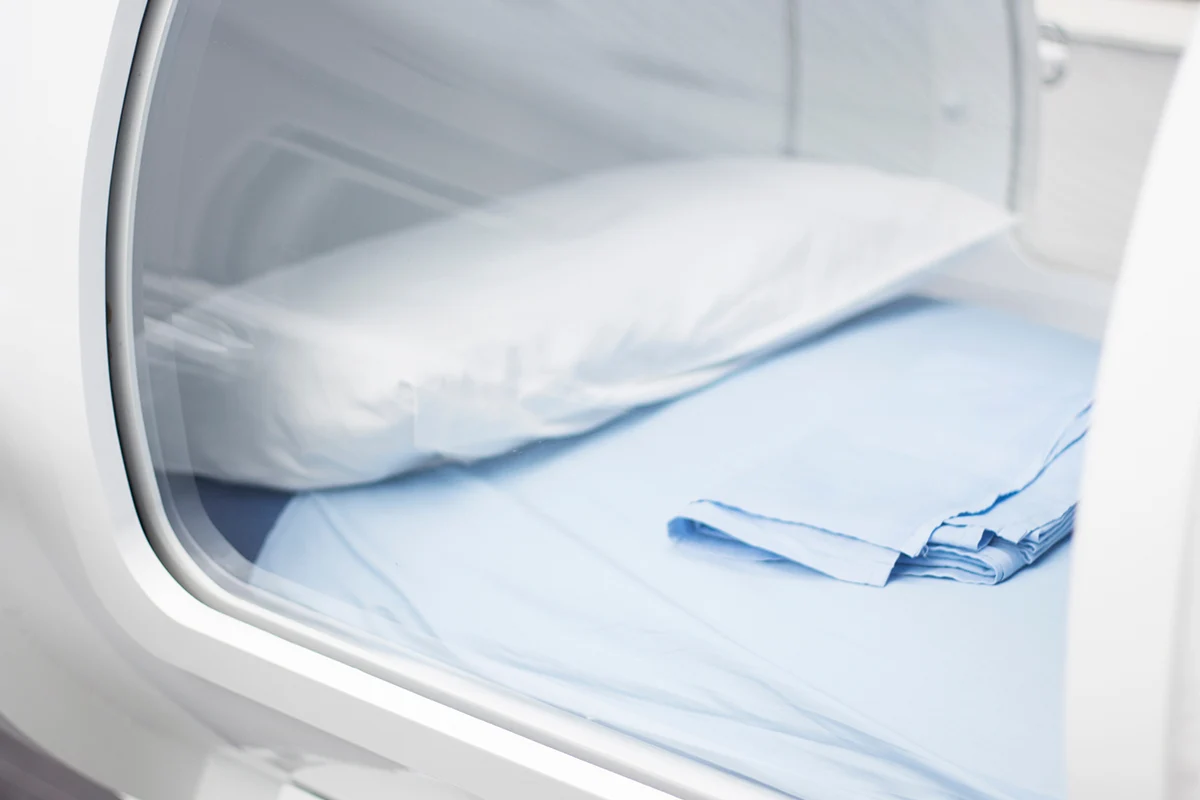Hyperbaric Oxygen Therapy (HBOT) for Post-Operative Healing in Facial Plastic Surgery: An Explainer

Picture a suspended animation capsule on a spaceship headed for a distant star. You have likely seen many iterations of this on film. The actor is frozen in a large cylinder, visible through a large glass window and surrounded by thick metal tubes and what appear to be rivets everywhere. This is not dissimilar to what you would witness at a hyperbaric oxygen therapy (HBOT) clinic.
HBOT has been available for decades, though it has more recently become popular among plastic surgeons and their patients for the purposes of improving healing post-operatively. And, unlike that suspended animation chamber of your imagination, patients are fully awake during HBOT treatment. In fact, they are usually watching television and can call "outside" through what appears to be an old-fashioned, black landline phone one would expect to see at the desk of an FBI agent. It is a fascinating process to witness.
How does HBOT work? Is it effective? I hope this blog post can answer these questions and more. The purpose of this blog post is to explain what HBOT is, what it is used for in facial plastic surgery, and to discuss the evidence for its safety and effectiveness.
What Is HBOT?
Hyperbaric oxygen therapy involves placing a patient in a pressurized chamber filled with pure oxygen. It is an environment in which patients are breathing pressurized pure oxygen which increases the oxygen content of blood plasma, thereby increasing the delivery of oxygen to tissues through the bloodstream. HBOT is also believed to result in selective constriction/narrowing of blood vessels in healthy tissue versus unhealthy tissue, thereby shunting more highly oxygenated tissue to areas that need it.
The theory behind HBOT is that increased oxygen delivery to tissues improves the healing process, especially for those wounds that are healing poorly due to patient-specific factors (1). These factors can include:
- A weak immune system (e.g. diabetes mellitus, treatment with chemotherapy)
- A post-operative/treatment reduction in blood flow to tissue (e.g. excess skin tension after a facelift, blockage of a vessel with hyaluronic acid filler)
Plastic surgeons reason that if HBOT can help with tissue that is healing poorly it can accelerate the healing process for otherwise healthy individuals recovering normally from surgical procedures.
What Is HBOT Used for in Facial Plastic Surgery?
HBOT is currently being used in both reconstructive (e.g. skin cancer reconstruction) and cosmetic (e.g. facelift) facial plastic surgery. The Undersea & Hyperbaric Medical Society has a list of fifteen (15) indications for which they approve the use of HOBT. Those related to facial plastic surgery are:
- Compromised flaps and grafts
- Arterial inefficiencies: Central Retinal Artery Occlusion
The Tenth European Consensus Conference on Hyperbaric Medicine agrees with the above indications (2). As a result, HBOT is used for surgical and non-surgical cosmetic procedures in facial plastic surgery such as (3):
- Poor healing of facial skin after facelift surgery due to a reduction in blood flow to that skin (1)
- Blockage of blood vessels after hyaluronic acid filler procedures leading to a reduction in blood flow to skin or other tissue (e.g. eyes) those blood vessels supply
Some otherwise healthy patients who are healing appropriately also elect to undergo HBOT in the hopes of accelerating the healing process.
Is HBOT safe?
HBOT is generally considered safe when treatment is performed by appropriately trained and experienced professionals in appropriately selected patients. It is not without side effects and risks, however. For example, it is common for patients to experience lightheadedness or fatigue after treatment for a short period of time.
Risks of HBOT are low but include, and are not limited to:
- Temporary nearsightedness (transient myopia)
- Damage to the ears (middle ear barotrauma)
- Oxygen toxicity seizure, though available research on cosmetic procedures has reported no cases of oxygen toxicity, possibly due to the shorter treatment regimens and lower pressures associated with cosmetic procedures (4)
There are some conditions for which a patient should not undergo HBOT, including, but not limited to:
- Epilepsy
- Pregnancy
- Heart failure
- Pneumothorax (lung collapse)
- Claustrophobia
- Patients taking certain medications (e.g. chemotherapeutic agents)
Is HBOT effective?
There is good research supporting the effectiveness of HBOT for chronic wounds that are healing poorly. There is more limited evidence supporting its use soon after surgery in acutely healing tissue (5). Therefore, it is not clear that HBOT can save skin and other tissues when there is evidence of significant damage due to inadequate oxygenation. However, the theory behind the effectiveness of HBOT in this scenario is sound and anecdotal reports from facial plastic surgeons suggest HBOT can be successful for both surgical and non-surgical procedures. For example, there are many case reports of the successful use of HBOT to combat the loss of oxygenation to facial tissue due to the unintentional blockage of blood vessels with hyaluronic acid filler. Moreover, it is considered a relatively safe procedure in appropriately selected patients. As a result, many facial plastic surgeons would argue that HBOT should be considered a treatment option if they have concerns about the health of tissue on the face soon after a procedure.
Unfortunately, there is simply insufficient evidence for a facial plastic surgeon to strongly recommend pre-operative or post-operative HBOT for cosmetic surgery in otherwise healthy patients healing appropriately unless the patient wants to try everything possible to maximize their healing potential. For example, the largest study examining otherwise healthy plastic surgery patients undergoing HBOT peri-operatively was on patients who underwent a "tummy tuck" procedure and no facial plastic surgery procedures (3, 4).
There may never be a large-scale, high-quality study (e.g. randomized-controlled trial) looking at treatment with HBOT for complications related to a loss of blood flow to tissue after surgical and non-surgical procedures in cosmetic surgery because these complications are so rare. In fact, we may be dependent on evidence for the effectiveness of HBOT on improving healing in compromised reconstructive flaps instead, for which there are multiple case reports and reasonable evidence for its effectiveness (6).
Conclusion
In short, hyperbaric oxygen therapy can be an appropriate treatment for many patients who demonstrate problems healing soon after surgery due to inadequate oxygenation of their tissues. It is dependent on the judgement of the surgeon as to whether this is occurring. Similarly, HBOT is one treatment option among many for those patients demonstrating insufficient blood flow to tissues after injectables procedures. Whether it accelerates the healing process for healthy patients healing normally is less clear.
References
- Tamaki A, Silverman DA, Ozer E. The Role of Hyperbaric Oxygen in Head and Neck Reconstruction and Facial Cosmetic Surgery. Facial Plast Surg. 2020 Dec;36(6):753-759.
- Parnis J, Magrin AMF, Hassan H. The role, safety, and efficacy of hyperbaric oxygen therapy in aesthetic practice-An evidence-based review. J Cosmet Dermatol. 2024 Jun;23(6):1940-1955.
- Fisher SM, Sherif RD, Borab ZM, Ganesh Kumar N, Rohrich RJ. Hyperbaric Oxygen Therapy in Aesthetic Medicine and Anti-Aging: A Systematic Review. Aesthetic Plast Surg. 2024 Dec 28.
- Mortada H, González JE, Husseiny YM, Al Jabbar I, Sultan F, Alrobaiea S, Neel OF. Efficacy of Hyperbaric Oxygen Therapy as an Adjunct in Aesthetic Surgery: A Systematic Review and Meta-analysis of Postoperative Outcomes and Complications. Aesthetic Plast Surg. 2025 Feb 26.
- Dauwe PB, Pulikkottil BJ, Lavery L, Stuzin JM, Rohrich RJ. Does hyperbaric oxygen therapy work in facilitating acute wound healing: a systematic review. Plast Reconstr Surg. 2014 Feb;133(2):208e-215e.
- Francis A, Baynosa RC. Hyperbaric Oxygen Therapy for the Compromised Graft or Flap. Adv Wound Care (New Rochelle). 2017 Jan 1;6(1):23-32.
Disclaimer
This blog post is for educational purposes only and does not constitute direct medical advice. It is essential that you have a consultation with a qualified medical provider prior to considering any treatment. This will allow you the opportunity to discuss any potential benefits, risks, and alternatives to the treatment.

Book Your Consultation
Take the first step toward enhancing your natural beauty by scheduling a personalized consultation with Dr. Jeffrey Harmon. As a double board-certified facial plastic surgeon trained by the pioneer of the extended deep plane facelift, Dr. Harmon offers expert guidance and care. Whether you're considering surgical or non-surgical options, our team is here to support your journey to renewed confidence.